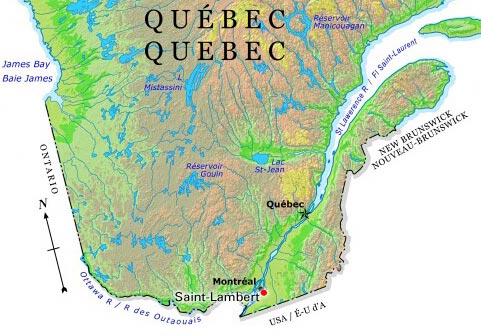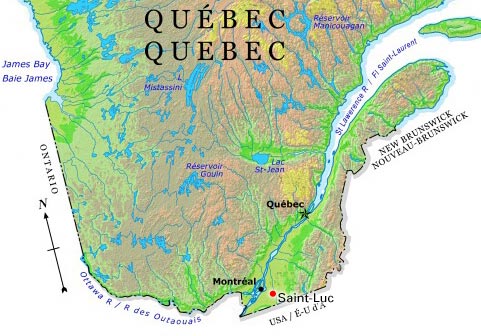Browse "Places"
-
Article
Saint John River
Saint John River, 673 km long, rises in northern Maine and flows northeast into the forests of Madawaska County to Edmundston, where it is joined by the Madawaska River and turns southeast, forming much of the border between Maine and New Brunswick. Saint John River is known as the Wolastoq by the Wolastoqiyik people, which means “beautiful river” in their language.
"https://d2ttikhf7xbzbs.cloudfront.net/media/media/150b0699-4963-43be-ada6-fe736bf4d819.jpg" // resources/views/front/categories/view.blade.php
https://d2ttikhf7xbzbs.cloudfront.net/media/media/150b0699-4963-43be-ada6-fe736bf4d819.jpg
-
Article
Saint Joseph's Oratory
Saint Joseph’s Oratory of Mount Royal is a minor basilica of the Roman Catholic Church. The Oratory is located on the northwestern slope of Mount Royal in the city of Montreal. (See also Côte-des-Neiges.) It is the tallest church in Canada and one of the largest domed structures in the world. The Oratory is an important landmark and symbol of Montreal, as well as a tourist attraction. Pilgrims come to visit it from all corners of the world. It attracts about 2 million visitors every year.
"https://d2ttikhf7xbzbs.cloudfront.net/media/media/Oratoire-saint-joseph.jpg" // resources/views/front/categories/view.blade.php
https://d2ttikhf7xbzbs.cloudfront.net/media/media/Oratoire-saint-joseph.jpg
-
Article
Saint-Lambert
Saint-Lambert, Quebec, population 21,861 (2016 census), 21,555 (2011 census). Saint-Lambert was settled beginning in the 17th century. It was first incorporated as a city in 1921 and reincorporated in 2006. Saint-Lambert was amalgamated into the city of Longueuil from 2002 until 2006 when it regained its municipal status. It is located along the South Shore of the St. Lawrence River across from Montreal, and is connected to that city by the Victoria bridge (completed 1859).Saint-Lambert is situated on the ancestral lands of the Kanyen’kehà:ka. The land remains unceded and is considered Indigenous territory.
"https://d2ttikhf7xbzbs.cloudfront.net/media/media/78498ea5-f87b-4f08-bb5a-240f93223ca7.jpg" // resources/views/front/categories/view.blade.php
https://d2ttikhf7xbzbs.cloudfront.net/media/media/78498ea5-f87b-4f08-bb5a-240f93223ca7.jpg
-
Article
Saint-Léonard (NB)
Saint-Léonard, NB, incorporated as a town in 1920, population 1343 (2011c), 1352 (2006c).
"https://development.thecanadianencyclopedia.ca/images/tce_placeholder.jpg?v=e9dca980c9bdb3aa11e832e7ea94f5d9" // resources/views/front/categories/view.blade.php
https://development.thecanadianencyclopedia.ca/images/tce_placeholder.jpg?v=e9dca980c9bdb3aa11e832e7ea94f5d9
-
Article
Saint-Louis Forts and Châteaux Archaeological Site
The Saint-Louis Forts and Châteaux archaeological site is located on top of a cliff overlooking the lower part of Quebec City, close to the Château Frontenac Hotel, under the Dufferin Terrace.
"https://d2ttikhf7xbzbs.cloudfront.net/media/media/3198c511-bb10-4183-acac-164a9c95e9eb.jpg" // resources/views/front/categories/view.blade.php
https://d2ttikhf7xbzbs.cloudfront.net/media/media/3198c511-bb10-4183-acac-164a9c95e9eb.jpg
-
Article
Saint-Luc
Saint-Luc was named by association with the neighbouring parishes of St-Martin and St-Marc. In 1963 it incorporated as the city of Saint-Luc with a population of 3218. Eel fishing was one of the mainstays of the economy. This industry remains part of present-day Saint-Luc.
"https://d2ttikhf7xbzbs.cloudfront.net/media/media/3a3e45fe-9cf1-4f08-ae79-06c5f7df3f4f.jpg" // resources/views/front/categories/view.blade.php
https://d2ttikhf7xbzbs.cloudfront.net/media/media/3a3e45fe-9cf1-4f08-ae79-06c5f7df3f4f.jpg
-
Article
Saint-Nicéphore
The municipality has its origins from 2 lumber communities which developed in the early 1800s, Wheatland and Watkins Mill. In 1873, Tourville Lumber Mills arrived in the area and began purchasing land for trees it shipped to its sawmill in Pierreville, downstream on the Rivère Saint-François.
"https://d2ttikhf7xbzbs.cloudfront.net/media/media/4c3501c2-ec99-4bc2-8942-eef4005efd49.jpg" // resources/views/front/categories/view.blade.php
https://d2ttikhf7xbzbs.cloudfront.net/media/media/4c3501c2-ec99-4bc2-8942-eef4005efd49.jpg
-
Article
Saint-Nicolas
Saint-Nicolas, Quebec, population 23,675 (2019), 16,645 (2001 census). The city of Saint-Nicolas was originally incorporated in 1994 with the amalgamation of the municipalities of Bernières and Saint-Nicolas. Since 2002, Saint-Nicolas is part of the city of Lévis. Saint-Nicolas is located 17 km southwest of Quebec City. Saint-Nicolas is on the south shore of the St. Lawrence River and to the west of Rivière Chaudière. It is a thriving residential suburb of Quebec City. The area is linked to the city of Sainte-Foy, on the opposite shore of the St. Lawrence, by the Pierre-Laporte suspension bridge and the old, cantilever Quebec Bridge. (See also Quebec Bridge Disaster.)
"https://development.thecanadianencyclopedia.ca/images/tce_placeholder.jpg?v=e9dca980c9bdb3aa11e832e7ea94f5d9" // resources/views/front/categories/view.blade.php
https://development.thecanadianencyclopedia.ca/images/tce_placeholder.jpg?v=e9dca980c9bdb3aa11e832e7ea94f5d9
-
Article
Saint-Pierre
In 1611, Samuel de CHAMPLAIN first made a reference to a small river that would later be named Rivière Saint-Pierre. A small community developed and this waterway made possible the construction of a large number of flour mills and sawmills.
"https://d2ttikhf7xbzbs.cloudfront.net/media/media/d5117ed8-6366-42c3-b566-0cb74f890d1c.jpg" // resources/views/front/categories/view.blade.php
https://d2ttikhf7xbzbs.cloudfront.net/media/media/d5117ed8-6366-42c3-b566-0cb74f890d1c.jpg
-
Article
Saint-Pierre and Miquelon
Saint-Pierre and Miquelon, French islands in the Gulf of St. Lawrence, 20 km southwest of the Burin Peninsula, Newfoundland and Labrador.
"https://d2ttikhf7xbzbs.cloudfront.net/media/media/9d6643b4-9d9f-4854-9b56-35ce14ffbffd.jpg" // resources/views/front/categories/view.blade.php
https://d2ttikhf7xbzbs.cloudfront.net/media/media/9d6643b4-9d9f-4854-9b56-35ce14ffbffd.jpg
-
Article
Saint-Quentin
Saint-Quentin, NB, incorporated as a town in 1992, population 2095 (2011c), 2250 (2006c). The Town of Saint-Quentin is located in northern New Brunswick in the Appalachian Highlands between the RESTIGOUCHE and MIRAMICHI rivers and tributaries of the SAINT JOHN RIVER.
"https://development.thecanadianencyclopedia.ca/images/tce_placeholder.jpg?v=e9dca980c9bdb3aa11e832e7ea94f5d9" // resources/views/front/categories/view.blade.php
https://development.thecanadianencyclopedia.ca/images/tce_placeholder.jpg?v=e9dca980c9bdb3aa11e832e7ea94f5d9
-
Article
Saint-Raymond
Saint-Raymond's industrial activity has always been closely linked to the forest industry. Sawmilling, pulp and paper, wood products, house and cottage manufacturing as well as charcoal production, are still key economic activities.
"https://d2ttikhf7xbzbs.cloudfront.net/media/media/eafda8a7-b679-46ed-bcc0-bd5a00bdc540.jpg" // resources/views/front/categories/view.blade.php
https://d2ttikhf7xbzbs.cloudfront.net/media/media/eafda8a7-b679-46ed-bcc0-bd5a00bdc540.jpg
-
Article
Saint-Romuald
Saint-Romuald, Quebec, population 13,435 (2019), 10,825 (2001 census). Originally incorporated in 1965, Saint-Romuald is located on the south shore of the St. Lawrence River. It is across from Sillery and is situated 19 km south of Quebec City. Since 2002, Saint-Romuald is part of the city of Lévis.
"https://d2ttikhf7xbzbs.cloudfront.net/media/media/Saint-romuald.jpg" // resources/views/front/categories/view.blade.php
https://d2ttikhf7xbzbs.cloudfront.net/media/media/Saint-romuald.jpg
-
Article
Sainte-Adèle
Sainte-Adèle, Qué, Town, pop 10 634 (2006c), 9215 (2001c), inc 1965. Sainte-Adèle is situated in the Laurentides region about 60 km north of Montréal. The Laurentides and Mont-Tremblant provincial parks are found to the north. In 1997 Sainte-Adèle annexed the village of Mont-Rolland (pop 2882, 1996c).
"https://d2ttikhf7xbzbs.cloudfront.net/media/media/b5046a48-3bfb-4a94-acd7-52ad59bde3da.jpg" // resources/views/front/categories/view.blade.php
https://d2ttikhf7xbzbs.cloudfront.net/media/media/b5046a48-3bfb-4a94-acd7-52ad59bde3da.jpg
-
Article
Sainte-Agathe-des-Monts
In the 19th century, Sainte-Agathe had only a few sawmills, but the construction of the Montreal and Occidental Railway in 1892 (replaced by the CPR in 1900) encouraged tourism and the development of the hotels that have become the region's economic mainstay.
"https://development.thecanadianencyclopedia.ca/images/tce_placeholder.jpg?v=e9dca980c9bdb3aa11e832e7ea94f5d9" // resources/views/front/categories/view.blade.php
https://development.thecanadianencyclopedia.ca/images/tce_placeholder.jpg?v=e9dca980c9bdb3aa11e832e7ea94f5d9
